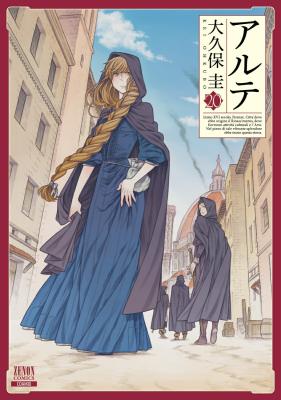[tab]As someone somewhat knowledgable in this area, there are a few things bothering me (e.g. the composition of a particular painting is anachronistic, the lack of difference between the visual art of the various regions of the Italian peninsula, and the fact that the only objection to Arte's goals is her sex, etc.), but overall this is exceedingly well done. The character development is great, and the characters are lovely and subtly original. I love how the main characters' motives centre around their passions rather than individuals and how the romance which gets (rather naturally, in this case) put in the mix does not hijack the story but instead adds to it, and the story never revolves around it. Arte, as a female protagonist is strong and politely rejects being assisted, insisting on reaching her goals with her own strength (although, I personally would not call her a tomboy). The art is gorgeous and the pacing is comfortable. Additionally, the time skips in the series, are well marked and are applied and handled very well. There are some historical details I hope to see, such as guilds, politics (which were tied in at the time, due to Florence's particular culture), competition between artists, and the movement of visual art from a craft to an art which was on going at the time. I’m also still uncertain of when in the Renaissance the series is set, although it has to be fairly early. That said, Ookubo-sensei, has done very good research, and nothing feels out of place.
[tab]For anyone who finds the age gap of a certain prospective couple involved to be strange, I can only point out that this was common in the day. Women were encouraged to marry somewhat early (although later than they were outside of Europe) for biological reasons, whereas men were encouraged to wait until they had established themselves and earned a reasonable sum. While this was most common among craftsmen, trained professionals, and the like, it was by no means unknown to nobility.
[tab]Side note: The early art historian, Giorgio Vasari, does include the life of Madonna Properzia de'Rossi and three other women in his The Lives of the Most Excellent Painters, Sculptors, and Architects (notably including Sofonisba Anguissola, who was a poor noblewoman herself and shows a few parallels to Arte). The Renaissance was the first era since antiquity in which individual secular women gained repute as artists; that said, women frequently would work along side their male relatives, as they had in the Middle Ages, during which most artists were not known by name. This is because visual art had been considered since antiquity to be a craft, being then considered manual labour. However, during the 15th and 16th centuries, individuals such as Leon Battista Alberti and the aforementioned Vasari placed emphasis on the intellectual elements leading to a rise in the status of visual art from the crafts to the arts, such as poetry; the status of artists rose accordingly. Additionally, since nobles were not supposed to work outside of those tasks restricted to them, being a noble and a professional artist was usually looked down on and opposed (their noble status did not change, however, unlike what the manga states at one point, although this could be a linguistic or translation issue), as such, it is always noteworthy when nobles did become artists, the most significant example being Michelangelo Buonarroti himself.
For more information:
Wikipedia on Female Artists
Wikipedia on the History of the Term "Artist"
[tab]It's a wonderful read and I'm looking forward to how it progresses!





